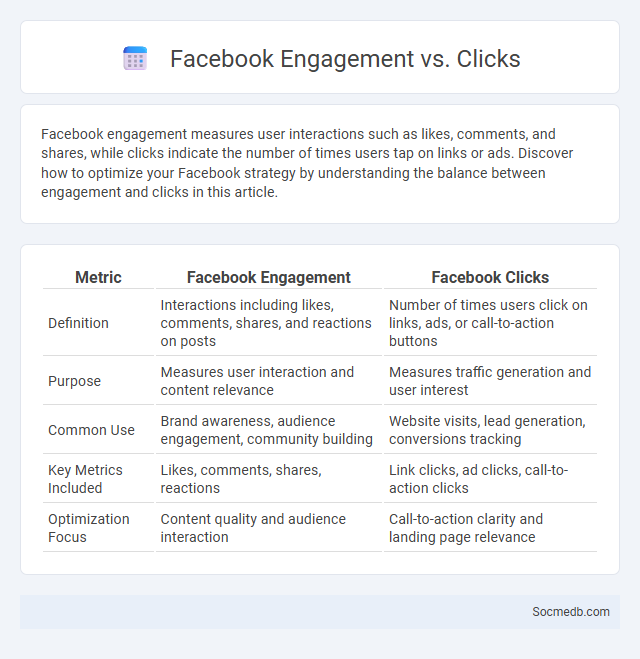
Photo illustration: Facebook Engagement vs Clicks
Facebook engagement measures user interactions such as likes, comments, and shares, while clicks indicate the number of times users tap on links or ads. Discover how to optimize your Facebook strategy by understanding the balance between engagement and clicks in this article.
Table of Comparison
| Metric | Facebook Engagement | Facebook Clicks |
|---|---|---|
| Definition | Interactions including likes, comments, shares, and reactions on posts | Number of times users click on links, ads, or call-to-action buttons |
| Purpose | Measures user interaction and content relevance | Measures traffic generation and user interest |
| Common Use | Brand awareness, audience engagement, community building | Website visits, lead generation, conversions tracking |
| Key Metrics Included | Likes, comments, shares, reactions | Link clicks, ad clicks, call-to-action clicks |
| Optimization Focus | Content quality and audience interaction | Call-to-action clarity and landing page relevance |
Understanding Facebook Engagement: What Does It Mean?
Facebook engagement measures how users interact with your content through likes, comments, shares, and reactions, reflecting the relevance and appeal of your posts. High engagement indicates that your audience finds your content valuable, increasing its visibility in the news feed due to Facebook's algorithm favoring interactive posts. To maximize your Facebook engagement, focus on creating meaningful content that encourages Your audience to connect and participate actively.
Defining Facebook Clicks: Types and Importance
Facebook clicks encompass various types such as link clicks, photo clicks, video plays, and call-to-action button clicks, each representing distinct user interactions critical for measuring engagement. Understanding these click types helps advertisers optimize ad performance and improve targeting strategies by analyzing which content drives the most valuable user actions. Accurate tracking of Facebook clicks directly impacts campaign ROI by providing insights into audience behavior and ad effectiveness.
Engagement vs Clicks: Key Differences on Facebook
Engagement on Facebook includes likes, comments, shares, and reactions that measure how users interact with your content, reflecting its resonance and appeal. Clicks refer specifically to actions such as link clicks, photo views, and video plays that indicate active interest in exploring your content further. Understanding the key differences between engagement and clicks helps you optimize your Facebook strategy to boost Your brand visibility and drive meaningful user actions.
Metrics That Matter: Analyzing Facebook Engagement
Measuring Facebook engagement involves tracking key metrics such as likes, comments, shares, and click-through rates to understand audience interaction. Your focus should be on the quality of engagement, including meaningful comments and shares that indicate genuine interest and connection with your content. Monitoring these metrics regularly allows you to optimize your social media strategy and improve overall brand awareness and customer loyalty.
Interpreting Clicks on Facebook Ads and Posts
Interpreting clicks on Facebook ads and posts involves analyzing user engagement metrics such as click-through rate (CTR), bounce rate, and conversion rate to assess campaign effectiveness. You should track demographic and behavioral data to understand which audience segments respond best, optimizing ad targeting for higher ROI. Accurate interpretation of these clicks helps refine content strategy and improve ad performance by identifying what resonates with your audience.
Why Engagement Rates Matter More Than Clicks
Engagement rates provide deeper insights into audience interaction by measuring likes, comments, shares, and time spent on content, which indicate genuine interest and brand loyalty. Unlike clicks, which only track immediate traffic, high engagement suggests sustained user attention and potential for long-term conversions. Brands leveraging engagement metrics can optimize content strategy for improved customer retention and stronger community growth.
Measuring ROI: Engagement vs Clicks
Measuring ROI on social media requires analyzing both engagement and clicks to understand your audience's interaction and conversion potential. Engagement metrics like likes, comments, and shares reflect brand awareness and community building, while clicks indicate direct user interest and drive traffic to your website. Your optimal strategy balances nurturing engagement to build loyalty and maximizing clicks to achieve tangible business outcomes.
When to Focus on Clicks in Your Facebook Strategy
Prioritize clicks in your Facebook strategy when your primary goal is driving direct traffic to your website, landing pages, or product catalogs. Campaigns aimed at boosting conversions, lead generation, or content consumption benefit significantly from click-optimized ads that target users most likely to engage. Utilize Facebook's click metrics and A/B testing to refine audience segmentation and maximize return on ad spend (ROAS) during peak engagement times.
Optimizing Content for Higher Engagement and Clicks
Optimizing your social media content for higher engagement and clicks involves crafting compelling headlines, using high-quality visuals, and incorporating clear calls-to-action tailored to your target audience's preferences. Leveraging analytics tools helps identify peak posting times and trending topics, ensuring your content reaches more users effectively. Consistently applying these strategies boosts interaction rates and drives increased traffic to your desired platforms or websites.
Best Practices: Balancing Engagement and Click Goals on Facebook
Optimizing Facebook strategies requires a balance between maximizing user engagement and achieving click-through goals through targeted content that resonates with the audience. Implementing data-driven insights such as peak activity times, compelling call-to-actions, and A/B testing enhances both interaction rates and conversion efficiency. Prioritizing authentic, visually-rich posts alongside precise audience segmentation ensures sustained engagement while driving high-quality traffic to desired landing pages.
 socmedb.com
socmedb.com